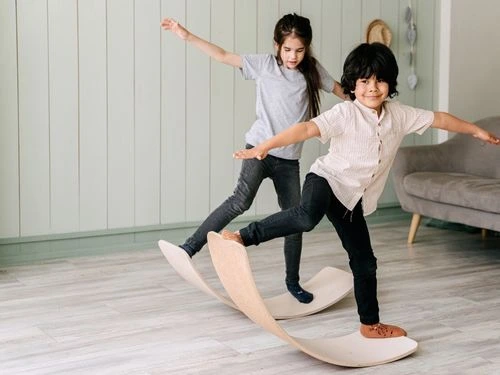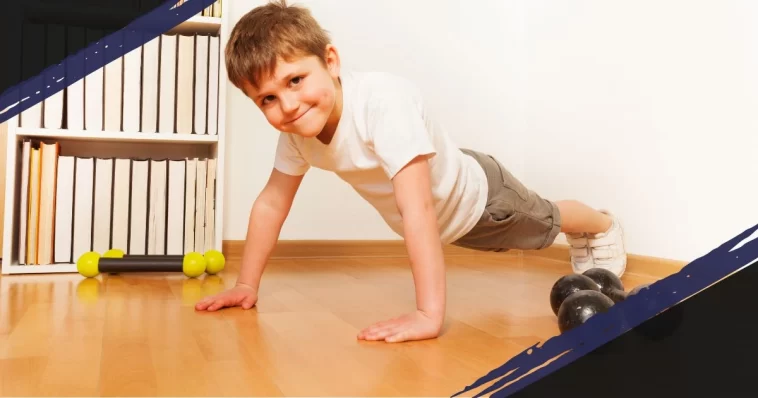In today’s fast-paced world, children often spend more time in front of screens than engaging in physical activity. While schools provide some opportunities for exercise, sedentary habits at home can make it challenging for kids to stay active. The good news is that parents and guardians can make fitness fun and accessible through kid-friendly home workouts. These exercises not only keep children physically healthy but also improve mood, concentration, and overall well-being.
Creating a routine that engages children in physical activity at home does not require expensive equipment or a large space. With a bit of creativity, parents can transform everyday spaces into activity zones where children can run, jump, stretch, and strengthen their bodies. The key is to design workouts that are enjoyable, age-appropriate, and varied, so kids are motivated to participate consistently.
Why Kid-Friendly Home Workouts Matter
Physical activity is essential for children for several reasons. It strengthens muscles and bones, promotes healthy growth, and helps maintain a healthy weight. Beyond physical health, regular movement supports mental and emotional well-being. Exercise releases endorphins, which help manage stress and anxiety while boosting mood. Additionally, engaging in physical activity encourages social skills and teamwork when done with siblings or parents.

Home workouts are especially beneficial because they allow children to exercise safely in a familiar environment. This can be particularly helpful during periods when outdoor activities are limited, such as during inclement weather or in urban areas with limited outdoor space. Home workouts also give parents the chance to actively participate with their children, creating bonding experiences and modeling healthy lifestyle habits.
Easy Kid-Friendly Home Workouts Tips for Active Kids
Setting Up a Kid-Friendly Home Workout Space
Before diving into specific exercises, it is essential to create a safe and inviting space for movement. The space does not need to be large, but it should be free of obstacles that might cause injury. Consider the following tips for creating a home workout area for children:
- Clear a Safe Zone: Remove furniture or objects that could be knocked over. Make sure there is enough space for jumping, stretching, and rolling.
- Use Soft Surfaces: Mats, carpets, or rugs can provide cushioning for exercises that involve sitting or lying on the floor.
- Accessible Equipment: Small, child-friendly equipment like foam balls, resistance bands, or jump ropes can make workouts more engaging without overwhelming children.
- Music and Motivation: Children often respond positively to music. Create a playlist of upbeat songs that keep energy levels high and make movement feel like play.
- Visual Guidance: Posters or visual cues can help children understand different exercises. You can even make a fun chart to track daily or weekly activity goals.
Warm-Up Activities for Children
Starting a workout with a warm-up is essential to prevent injuries and prepare the body for movement. For kids, warm-ups should be playful and dynamic rather than rigid. Here are some kid-friendly options:
- Animal Walks: Encourage children to move like different animals. They can crawl like bears, hop like frogs, or waddle like penguins. This warms up muscles while keeping it fun.
- Follow the Leader: Have children mimic your movements in a series of simple stretches or dynamic moves such as marching in place, arm circles, and high knees.
- Dance Party: Put on a favorite song and let kids dance freely for a few minutes. Dancing increases heart rate and coordination.
- Jumping Jacks: A classic exercise that gets the blood flowing. Children can do sets of 10-20 repetitions at their own pace.
Kid-Friendly Cardio Exercises
Cardiovascular exercise is crucial for developing heart and lung health. For children, cardio should be active, engaging, and imaginative. Here are some excellent options for home:
- Obstacle Courses: Use household items like chairs, cushions, and towels to create a mini obstacle course. Kids can climb over cushions, crawl under tables, and jump over obstacles. This activity challenges coordination, agility, and stamina.
- Jump Rope: A simple jump rope can provide a fun and challenging cardio workout. Children can learn different skipping styles, such as single jumps, double jumps, or alternating feet.
- Scavenger Hunt: Turn cardio into a game by organizing a scavenger hunt. Hide items around the house and set a timer for children to find them while moving quickly.
- Dance Routines: Simple choreographed dances to their favorite songs can keep kids moving while improving rhythm and coordination. Parents can join in, making it a family activity.
Strength and Muscle-Building Exercises
Strength exercises are essential for developing strong bones and muscles in growing children. Bodyweight exercises are ideal for home workouts because they require no equipment and are safe for young children.
- Push-Ups: Modified push-ups with knees on the ground can help children build upper-body strength.
- Squats: Teach proper form by having children stand with feet shoulder-width apart, bend their knees, and lower their hips as if sitting in a chair.
- Plank Challenges: Planks strengthen the core and can be made fun by challenging children to hold the position for progressively longer times.
- Wall Sits: Children can lean against a wall with knees bent as if sitting in an invisible chair. Add a playful element by timing them or counting repetitions.
- Toy Lifts: Use small, lightweight toys or stuffed animals as resistance for lifting exercises. Children can pretend they are lifting “weights” while developing arm and shoulder strength.
Flexibility and Balance Exercises
Flexibility and balance are vital for overall physical development. Stretching exercises improve range of motion and reduce the risk of injury, while balance activities enhance coordination.
- Yoga for Kids: Simple yoga poses like the tree pose, butterfly pose, or downward dog are excellent for flexibility and balance. You can follow online videos or create your own routine with storytelling elements.
- Balance Beam: Use a tape line or a narrow plank to create a makeshift balance beam. Children can practice walking forwards, backwards, or sideways to develop stability.
- Stretching Games: Incorporate stretching into games. For example, “Touch the Ceiling” or “Reach for the Stars” encourages kids to stretch arms and legs while having fun.
- One-Legged Challenges: Standing on one leg for as long as possible strengthens core muscles and improves balance. Add variations, such as passing a ball to a partner while balancing.
Incorporating Fun and Imagination
The most successful home workouts for children are the ones that feel like play. By incorporating imagination and creative scenarios, children are more likely to participate actively.
- Superhero Workouts: Children can perform exercises like “super jumps” or “cape spins” while pretending to be their favorite superheroes.
- Adventure Themes: Transform a living room into a jungle, a pirate ship, or a magical castle. Activities such as “jump over lava” or “crawl under vines” engage both body and mind.
- Story-Based Routines: Create a short story where the child must complete physical tasks to progress through the narrative. This makes the workout immersive and enjoyable.
- Family Challenges: Make workouts social by inviting siblings or parents to join. Friendly competitions, like who can hold a plank the longest, motivate children and foster positive reinforcement.
Incorporating Strength and Conditioning Equipment
While most home workouts for kids rely on bodyweight exercises, adding a few simple pieces of equipment can increase engagement and variety.
- Resistance Bands: Lightweight bands can be used for pulling, stretching, and strength-building exercises.
- Mini Dumbbells or Soft Weights: Small, safe weights allow children to explore resistance exercises under supervision.
- Balance Boards or Stability Discs: These improve balance, coordination, and core strength playfully.
- Hula Hoops: Hooping strengthens core muscles and improves coordination while being entertaining.
Making Workouts Consistent
Consistency is key to building healthy habits. To keep children engaged, it is essential to establish a regular workout routine that fits their energy levels and schedules. Consider the following strategies:
- Short Sessions: Young children often have limited attention spans. Workouts of 15 to 30 minutes are sufficient and more effective than longer, unfocused sessions.
- Daily Movement Goals: Set a goal, such as 60 minutes of active movement per day, broken into multiple short sessions.
- Track Progress: Use charts, stickers, or small rewards to track workouts and celebrate accomplishments. This adds a sense of achievement and motivation.
- Mix It Up: Avoid monotony by rotating different exercises, games, and activities. A variety of movements ensures full-body development and keeps workouts interesting.
Safety Considerations
While home workouts are generally safe, parents should pay attention to safety to prevent injuries:
- Ensure children wear comfortable clothing and appropriate footwear.
- Avoid high-impact exercises on hard floors; mats or rugs can help absorb impact.
- Supervise exercises that involve jumping, lifting, or balancing, especially for younger children.
- Encourage children to listen to their bodies and take breaks if they feel tired or uncomfortable.
Nutrition and Recovery
Physical activity is only one part of a healthy lifestyle. Proper nutrition and adequate rest are essential to support growth, recovery, and energy levels. Encourage children to eat a balanced diet with plenty of fruits, vegetables, whole grains, and protein. Hydration is equally important, especially during or after workouts. Incorporating rest days or lighter activity days helps prevent overuse injuries, allows muscles to recover, and keeps children motivated for future workouts.
Sample Weekly Kid-Friendly Workout Plan
To make it easier for parents, here is a sample weekly plan that balances cardio, strength, flexibility, and fun activities:

- Monday: Animal walk warm-up, jumping jacks, squats, and dance party cool-down.
- Tuesday: Obstacle course challenge, plank games, stretching, and story-based superhero routine.
- Wednesday: Jump rope cardio, wall sits, hula hoop core exercises, and yoga for kids.
- Thursday: Scavenger hunt, cardio, push-ups, toy lifts, and balance beam exercises.
- Friday: Dance routine warm-up, lunges, one-legged challenges, and stretching games.
- Saturday: Family workout challenge with a mix of favorite exercises and fun games.
- Sunday: Active rest day with light stretching, walking, or outdoor play.
This plan is flexible and can be adapted to suit the child’s age, interests, and fitness level.
Encouraging Lifelong Fitness
The ultimate goal of kid-friendly home workouts is not only immediate physical activity but also fostering a lifelong habit of staying active. By making workouts enjoyable, interactive, and age-appropriate, children develop positive associations with movement. Parents who actively participate, celebrate successes, and foster a playful environment help instill confidence, resilience, and a sense of the importance of health in their children.
Encouraging children to explore different types of movement, from dancing and yoga to strength exercises and cardio games, ensures a well-rounded approach to fitness. It also allows children to discover which activities they enjoy most, increasing the likelihood that they will continue being active as they grow.
Making Fitness Fun for Kids Every Day
Kid-friendly home workouts are a practical, fun, and effective way to promote physical activity, mental well-being, and healthy habits in children. By incorporating playful exercises, imaginative games, and age-appropriate strength and cardio routines, parents can make fitness an enjoyable part of daily life. With a safe space, creative ideas, and consistent encouragement, children can develop the physical and emotional resilience needed to thrive both at home and beyond.
Remember, the goal is not perfection but participation and enjoyment. Whether it’s jumping like a frog, balancing on a tape line, or dancing to a favorite tune, every movement counts toward building a healthy, active, and confident child. Home workouts can be the foundation of a lifelong love for fitness, helping children embrace a healthy and happy lifestyle from an early age.



